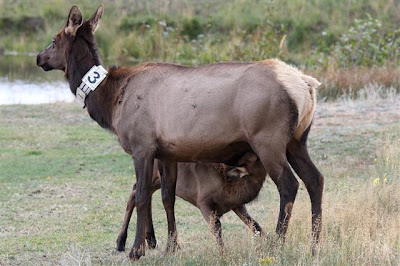The elk are usually most active around dawn and dusk. We headed into the park at about 5 pm.
 In Horseshoe Meadow, there were easily over 100 elk - and even more park visitors watching the elk.
In Horseshoe Meadow, there were easily over 100 elk - and even more park visitors watching the elk.Park rangers and volunteers were on hand to make sure people and elk were all safe.
 We got excellent views of male elk sparring from less than 50 feet (15 meters) away.
We got excellent views of male elk sparring from less than 50 feet (15 meters) away.In the fall, the elk in Rocky Mountain National Park, descend from the high country into meadows where they form fall herds with one male and a group of females.
The males fight to defend their herd - although the females have a choice in the matter as well and will sometimes head off to join a different herd.

We were lucky to be in the park tonight. There were at least 36 males in our view at one point. When there are that many male elk together during breeding season, there are sure to be lots of elk antics.
 The elk tend to choose sparring partners about their same size. I love the two little "spikes" standing side by side. Sometimes they'd spar. Sometimes they'd eat. It will be a few years before either of them is big enough to have his own herd.
The elk tend to choose sparring partners about their same size. I love the two little "spikes" standing side by side. Sometimes they'd spar. Sometimes they'd eat. It will be a few years before either of them is big enough to have his own herd. The elk bugle to attract females and defend their harem from other males.
The elk bugle to attract females and defend their harem from other males.The elk in RMNP have a high pitched bugle that carries well in the open fields where they group. In Yellowstone, the elk rut occurs in forested areas, so elk watching isn't as simple. In Yellowstone, the elk bugle is lower pitched, which carries better through a forest.
 These two males are big enough to be contenders for their own harems. They shed their antlers every year. A rack of antlers like this weighs approximately 55 pounds (25 kilos).
These two males are big enough to be contenders for their own harems. They shed their antlers every year. A rack of antlers like this weighs approximately 55 pounds (25 kilos). This male is bugling, as if to tell his cows to gather round, and to chase off that other male who's in his territory.
This male is bugling, as if to tell his cows to gather round, and to chase off that other male who's in his territory.Watching the elk interact reminded me of watching a sporting event. There were a lot of tactics, with various males trying to free females from other herds.
 As darkness settles, I hope the male elk gets to rest at least a bit. The males with harems lose up to 20% of their body weight during the rutting season because they're so busy defending their harem that they don't have much time to eat.
As darkness settles, I hope the male elk gets to rest at least a bit. The males with harems lose up to 20% of their body weight during the rutting season because they're so busy defending their harem that they don't have much time to eat.We definitely hit the elk jackpot on this visit!















































